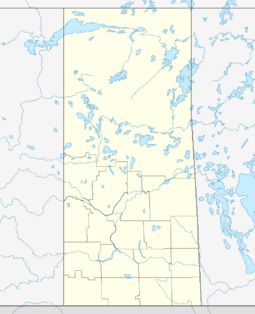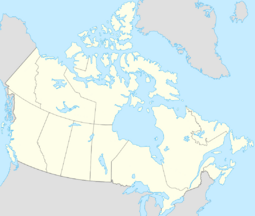Cannington Manor Provincial Park facts for kids
Quick facts for kids Cannington Manor Provincial Park |
|
|---|---|
|
IUCN Category III (Natural Monument)
|
|

All Saints Anglican Church
|
|
| Location | Saskatchewan, Canada |
| Nearest city | Carlyle |
| Established | 1986 |
| Governing body | Saskatchewan Provincial Parks |
Cannington Manor Provincial Park is a special historical park located in the southeast part of Saskatchewan, a province in Canada. It's found in the RM of Moose Mountain. This park was once home to a unique English settlement.
In 1882, a man named Captain Edward Michell Pierce started an English colony here. It was a place where young men from wealthy English families came to learn how to farm. This historical site officially became a provincial park in 1986.
Cannington Manor is about 16 kilometers (10 miles) southeast of Moose Mountain Provincial Park. It is also about 60 kilometers (37 miles) south of the town of Moosomin.
Contents
A Unique English Colony
Captain Pierce created an agricultural college at Cannington Manor. He invited young men, often called "remittance men," to study there for a fee. These were usually sons of rich families who were sent money from home. The goal was to teach them how to farm and build a life in the Canadian West.
For example, three brothers named Ernest, Billy, and Bertie Beckton built a ranch house called "Didsbury" within the colony.
Life in the Colony
Life at Cannington Manor was very different from the usual pioneer experience. The settlers here tried to live like the upper-class people in England. They enjoyed many fancy activities, such as:
- Thoroughbred horse racing
- Polo matches
- Theatrical plays
- Fox hunting
- Billiards
- Soccer
- Tennis
This was a big contrast to the other settlers nearby. Most homesteaders worked very hard just to survive. They had to improve their land to earn ownership from the government.
Growing the Community
As the colony grew, more buildings were constructed to support the people living there. These included:
- A dairy
- A school, which also served as a town hall
- A blacksmith shop
- The Moose Mountain trading company store
- Harold Fripp's flour mill
- C.E. Phipps Land Titles Office
- A carpenter shop
- The Mitre hotel
The community quickly grew to about 200 residents.
Why the Colony Ended
Several things led to the end of the Cannington Manor colony.
Important People Leave
Captain Pierce, who founded the community, passed away on June 20, 1888. Other important people also started to leave.
- C.E. Phipps, who ran the land titles office, moved to Oxbow in 1891.
- Spencer Page, the first teacher, left in 1894 to go into politics.
- Louis Kent, the second teacher, worked from 1894 until he passed away in 1896.
- Robert Bird, the storekeeper, moved to British Columbia in 1898.
- Ernest Maltby, the postmaster, and his wife Mary, who arrived in 1892, also moved to British Columbia in 1901.
The Railway and Other Challenges
Between 1901 and 1902, the Canadian Pacific Railway (CPR) built a new train line. However, it was built about 10 kilometers (6 miles) south of the village, not through it. In those days, people traveled mostly by horseback, so this distance made it hard for the community to grow.
Along with the founder's passing, a period of dry weather (drought) and low prices for grain made it very difficult for settlers to continue their lifestyle at Cannington Manor. Because of these challenges, the colony eventually faded away.
Exploring the Historic Sites
Today, Cannington Manor Provincial Park is made up of two separate areas.
The Village Site
The first area is about 15 hectares (37 acres). This part contains the remains of the original village. You can see where buildings once stood, and there are also several replica buildings that show what the village looked like.
Near the park entrance, there is a schoolhouse from the 1920s. This building now serves as the park's visitor center.
All Saints Anglican Church, built in 1884, is also near the center of the village site. This church is still used today, though it is not part of the park property. It is recognized as an important historical place on the Canadian Register of Historic Places.
The Humphrys/Hewlett House
The second area of the park is about 32 hectares (79 acres) and is located 3 kilometers (1.9 miles) west of the village site. This area includes an old farmyard and a large, two-and-a-half-story wooden house. You can also see the remaining walls of two stone outbuildings.
The house, built in 1888, is known as the Humphrys/Hewlett House. It is also listed on the Canadian Register of Historic Places. Both the house and the village site were officially recognized as historic places on May 26, 1986, and added to the Register on November 1, 2006.
Gallery
See also
- List of protected areas of Saskatchewan
- List of historic places in rural municipalities of Saskatchewan
- St. Hubert Mission
- Tourism in Saskatchewan






